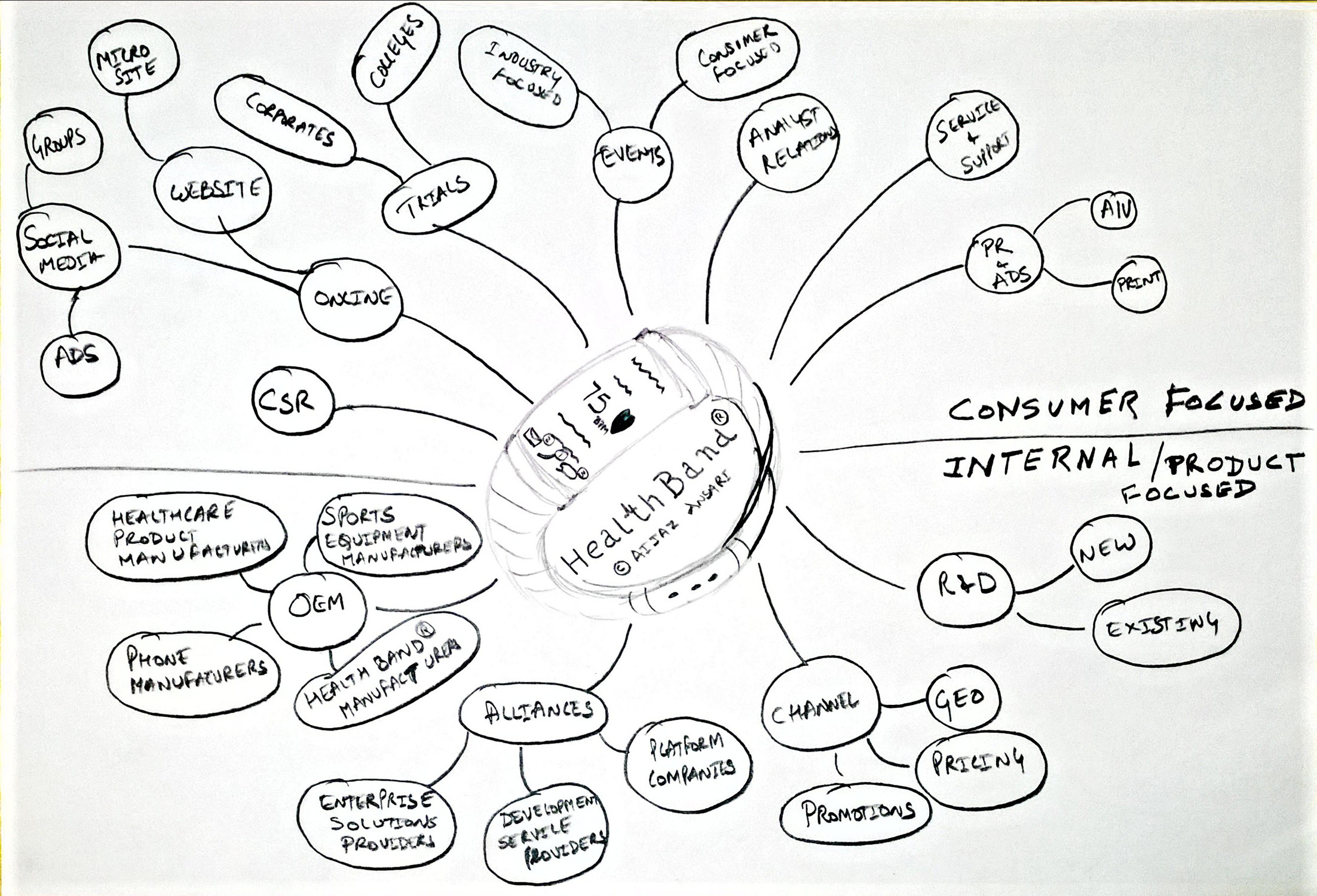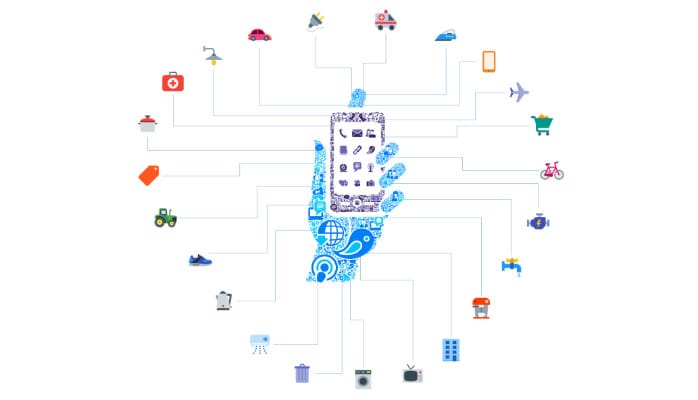So, how will you market an IoT product?

IoT or (if you apply logic) IT product marketing for dummies
I have been recently asked this question; ‘how will you market an IoT product?’ I answered and thought of writing about it too. To me, the fundamentals of marketing remain. My experience has been majorly in B2B marketing but I believe marketers just need to choose the right combination of channels, market mix, and the message to get it right (there are slight differences in marketing for B2C as opposed to B2B). Having said that, this post will provide a visual aid to fellow marketers, founders, CEOs, and start-ups to market their products well. I could easily relate to a wearable so here we go;
To make this simple, I have split marketing efforts into two:
Consumer-Focused: All marketing efforts that are consumer-facing and directly affect revenue
&
Internal / Product Focused: Marketing efforts that ensure product sustenance and innovation
(not in any particular order)…
- Consumer-Focused:
- CSR: Corporate Social Responsibility (CSR) is often ignored / ‘kept in thoughts’ by leaders. As the product here is so ‘close at hand’, showing the human side of a business is important. Also, CSR helps you do the right thing.
- Online: Your online presence is the face of your business. The most important medium if you want to thrive. Two major areas where marketers need to invest their sizeable time and energy:
- Website: If an image says 1000 words, your website is your poetry! Let’s be honest, we Google literally everything. Search for your product starts online and it is no secret. Having a simple to navigate and brilliant to look at site amplifies your growth. Building a great site should be your topmost priority. Website is also a portal for you to sell your products directly to the consumer. This will hop-over your supply chain and save you money.
- Add to that, a microsite will not only add depth to your SEO efforts but also help scale into a multi-brand business.
- Social: As technology moves on, new channels evolve and social media is one such channel. Not the end-all, but it must be treated as a vehicle to deliver your message to your audience. Very important if your focus is B2C.
- Groups: Specific to your products, groups will drive customer loyalty (if there is anything like it in today’s competitive environment) and engagement.
- Ads: Non-interruptive Ads can not only be effective in generating sales but also put an early word out in the market.
- Trials: Trials manifest your promises made over a product. Winning over a customer’s trust requires giving them a sample of what you’ve built. Trials not only help sell but also collect valuable feedback for your next iteration. With wearable’s, huge potential exists with college-goers and young (tech-savvy) employees. Freebies can also be given if one submits feedback that will only help build a better product.
- Events: Nothing beats meeting your suspect / prospects /customers in-person. Events is a great way to engage and brand your product. I remember this quote from my good ‘ol sales days: “Showing up is half the sale”. Showing-up where your target expects you the most (and least in some cases) is imperative.
- Industry-specific: These tells your alliances that you are serious about what you do. You can also assess the competition and pick-up on market cues.
- Consumer specific: These events, well they instil confidence in your customers. This way, you can also create a ‘Cool’ factor for your product and make it more likeable.
- Analyst Relations: If you want to kill the big fish, this is your speargun. Getting the relationship right will take your small cash strapped enterprise to great heights and may also help you quickly close-in on your exit strategy. It’s like beating your chest and saying, ‘here I am’.
- Service and Support: Every product breaks and needs fixing. Service and support are not only a given but is a great medium to take end-of-the-value-chain feedback. The sum of all experiences, if you will.
- PR & Ads: If you want to turbo-power sales and brand visibility, here’s your NOS. The best part is, you only spend when you turbo-charge.
- PR: Agencies feed on your ideas and innovation. They want to put out your story as much as you like to. Pick-choose what you want your PR Agent (if you can afford one) to handle as not all may be done in-house by your marketing team. Writing blogs is a good starting point. Ensuring you are talking to your agency often ensures they talk your lingo.
- Ads: Today, Audio / Video and Print ads are easy to make and distribute. So, if there is a new product update / a store opening up / fresh perspective to be shared, press the red button and go zoom!
- Website: If an image says 1000 words, your website is your poetry! Let’s be honest, we Google literally everything. Search for your product starts online and it is no secret. Having a simple to navigate and brilliant to look at site amplifies your growth. Building a great site should be your topmost priority. Website is also a portal for you to sell your products directly to the consumer. This will hop-over your supply chain and save you money.
- Internal / Product Focused
- OEM: Original Equipment Manufacturers ensure your promise to deliver the product on time is upheld. Also, a change in your products design / material reaches the market just in time to avoid your marketing budget from running out and the competition catching-up.
- Healthcare Product Manufacturers: As it is a wearable, and to keep your product current with the latest trends, monitoring the health of the wearer is a given. Partnering up with healthcare product (and let me also include healthcare device) manufactures, will give an edge over others to be customer-centric and make the device more personal. Targeted ads can be fired on the device if a certain anomaly is found against the wearers benchmarked aggregates. Another area, much ignored, could be the clinics and independent healthcare practitioners. Many Medical Reps visit doctors to promote their medicines and educate on new drugs. On the same format, if this device can be pitched as a healthcare device, doctors can monitor their patients’ health 24/7 and attend to their immediate needs. This can tie-back to insurance providers and premiums can be adjusted at a more granular level.
- Phone Manufactures: Phone companies like Nokia, Samsung, HTC, Apple etc. provide a great platform for your product as it can be bundled along with their premium devices. Providing native integration with handhelds could be uncharted territory for solidifying your brand’s market presence and (if done well) could help you dominate the space.
- Sports Equipment Manufacturers: Bundling the device with sports equipment is a great way to promote the product and create a positive impact on your brand. You can take it to the next level by enabling sensor data feed to your wearable and gain deeper insights into your wearer’s habits. The possibilities are countless.
- Health Band™ Manufacturer: Relationship with your products’ manufacturer is critical (I cannot emphasis more). Your Go-To-Market plans’ success relies heavily on this relationship. You can tweak the output and quality of your device versions if you keep your producer happy. Not just that, if you listen closely, your vendor can give you insights from the source that perhaps no market research can deliver.
- Alliances: Your solution and services partners can greatly contribute to your products’ growth. Integration and availability of service can affect user experience on many levels.
- Platform Companies: Platforms are opportunities to show your impact and reach to your customers and partners. A classic case could be to make your API available on Marketo, Salesforce, etc. platforms and let companies integrate and push amazing content by gaining insights into the wearers’ lifestyle.
- Development Service Providers: These guys are the ones that help your product integrate with other products (hardware / software) by writing scripts. Partnering with these companies will ensure your ecosystem is homogeneous and someone’s always available to get things going when there is a need.
- Enterprise Solutions Providers: These are the classic software product (ERP, CRM, MAP, and HRM) companies. They always want to expand their footprint and provide APIs for easy integration. Think of what a Hospital Information System (known by various names) can gain if an out-of-the-box integration is available with your device. If you show-up when the deal is being struck, you can influence the doctors to recommend their patients to buy your product at a discounted rate.
- Channel: Here’s the Sales piece that marketer’s dictate (think Sales as a sub-set of Marketing). Channels take your awesome product to your potential buyer. Without Channels, you will run thin on cash and staff.
- Promotions: Channel Marketing ensures a system of links / streams / channels thru which your product reaches your end-user. They can be physical or virtual stores. An online store is a great way to get your product ‘out-there’ in front of millennials. Scheduled campaigns and promotions (incentives) drive business growth.
- Pricing: I considered pricing under channel as this is where the tyre hits the tarmac! Once you have your final landing cost, you can modulate your profit margin to optimise your channel and give your competition a run. Essentially, pricing is done before your operation takes-off. So, you know what you are getting yourself into and what you can expect. Once done, the idea is to quickly enter the market so that your pricing does not ‘turn’ (stale in this context). There are tons of books written on pricing and you will also require your Finance team to help you here.
- Geo: What geography you’d like to sell to have a great influence on your entire plan. Switching from Europe to Asia could mean you need to bring in a significant change in your pricing and messaging. The new channel will have to be identified and activated for smooth entry. Local taxes and workforce will require you to localise your business to suit the needs of the country. Newer alliances and perhaps a change in product quality may be in order.
- R&D: Research and Development ensure your product stays current and feed the manufacturer of your device with features that your users need now and in near the future. Launching a feature too early or arriving late to the party could land a deathly blow to your product. You may be rushing thru the product lifecycle toward an abrupt decline. Marketers share joint responsibility with the R&D and Manufacturer to ensure the right features are built at the right time for the target market.
- Existing: Innovation in existing product and features can extend the life of the product and help lengthen the growth and maturity of your product’s life.
- New: New features enhance your products’ desirability and disrupt the marketspace. A lag in providing features to the market can severely affect your launch. The way companies are offering free upgrades users, you may want to check backward compatibility with older versions. This may be necessary if the gap between the two launches is small.
- OEM: Original Equipment Manufacturers ensure your promise to deliver the product on time is upheld. Also, a change in your products design / material reaches the market just in time to avoid your marketing budget from running out and the competition catching-up.
What you see above is not a plan but a 30K Ft. view (I know it’s a cliché) of how it will all come together. A plan requires you to detail cost and time estimate by selecting what you can focus on, phase-wise. I tried to keep my post strategic as getting tactical will require quite a few pages to be filled! While this was done over lunch, if I have missed out on something, please write to me.
Remember: Marketing and Innovation (in that order) are the two essential, and only, pillars of any successful business.

Free: PDF version of this post here.
Now, tell me…do you want to get your product off the ground? Well, I can help you do just that!
Note: Health Band is a fictitious product name! Go steal 🙂






